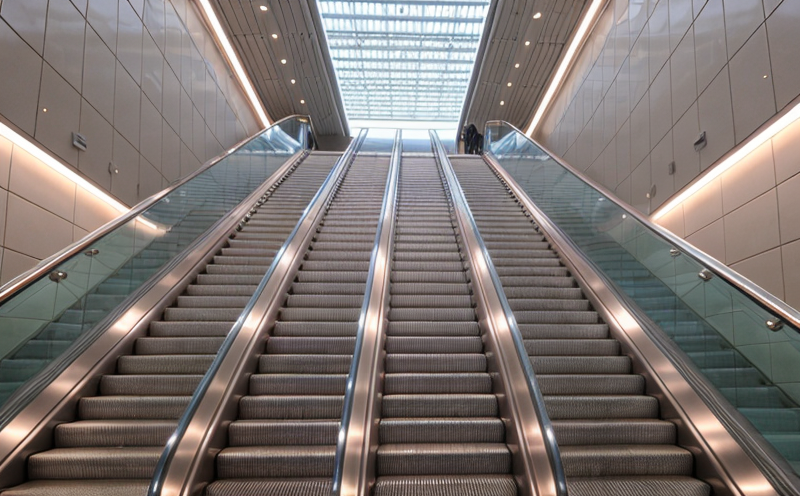Escalator lighting inspection
The safety and functionality of escalators are paramount in ensuring public safety. Escalator lighting plays a crucial role in enhancing visibility, reducing the risk of accidents, and maintaining compliance with international standards such as ISO 11670:2008, which specifies requirements for the design, construction, installation, and maintenance of passenger transport escalators and moving walks.
During an inspection, we assess whether lighting meets specified criteria ensuring that the luminaires are correctly installed, securely fixed, and properly aligned. We check if the lights are free from damage or loose fixtures, which could lead to safety hazards. The inspection also evaluates the brightness levels of the lighting, as per the standards set by the Illuminating Engineering Society (IES), to ensure they meet the minimum requirements for passenger visibility.
In addition, we examine the type and quality of bulbs used in compliance with local regulations and manufacturer specifications. We inspect all emergency lighting systems to confirm that they are operational and that their brightness meets the prescribed levels. This ensures that passengers can see clearly during both normal operation and emergencies.
Our team also checks the control panels for any signs of wear or malfunction, which could affect the overall performance of the lighting system. We ensure that all wiring is intact, secure, and not exposed to potential hazards such as water or moisture. This comprehensive approach guarantees that the lighting systems are in optimal condition, thereby enhancing passenger safety and comfort.
By adhering to these rigorous inspection protocols, we can provide peace of mind to property owners and managers by ensuring their escalators meet all necessary standards for public use. Our team is equipped with state-of-the-art tools and expertise to conduct thorough inspections that go beyond the minimum requirements set by regulatory bodies.
Industry Applications
Elevator and escalator lighting inspection services are critical in various sectors where public safety is of utmost importance. These include commercial buildings, shopping malls, transportation hubs such as airports and train stations, hospitals, and high-rise residential complexes.
- Commercial Buildings: In these environments, proper lighting ensures efficient operations and a safe working environment for employees. It also enhances the aesthetics of the premises, which is crucial for attracting customers and tenants.
- Shopping Malls: With the continuous flow of visitors, it's essential to maintain clear visibility at all times. Proper lighting not only ensures safety but also contributes to reducing the risk of slip-and-fall accidents, a significant concern in such areas.
- Airports and Train Stations: These high-traffic areas require comprehensive lighting inspections to ensure that passengers can navigate safely and efficiently. This is particularly important during night-time operations when natural light is limited.
- Hospitals: Safety and efficiency are critical in healthcare settings, where even minor issues with lighting could lead to serious safety risks for patients and staff.
- High-Rise Residential Complexes: Ensuring that lighting systems function correctly is vital to maintaining the quality of life for residents. It helps create a secure environment and contributes to overall comfort and satisfaction.
Quality and Reliability Assurance
The inspection process for escalator lighting involves several key steps that are designed to ensure the highest level of quality and reliability. We start by reviewing all relevant documentation provided by the manufacturer, including technical specifications and installation manuals.
We then conduct a visual inspection of the lighting system, examining every component from the fixtures themselves down to the wiring harnesses. This includes checking for any signs of wear or damage that could indicate potential hazards. We also test the functionality of emergency lights to ensure they are operational when needed.
For a more detailed assessment, we may use specialized equipment such as light meters and scopes to measure brightness levels accurately. These measurements are compared against the standards set by relevant bodies like IES and ISO to determine if they meet acceptable thresholds for visibility.
We also perform stress tests on lighting fixtures to simulate real-world conditions under which they will operate. This helps us identify any potential weaknesses or vulnerabilities in the system before they become actual problems. By doing so, we can recommend preventative maintenance measures that extend the lifespan of the lighting fixtures and reduce the likelihood of failures.
The final step is compiling a detailed report summarizing our findings along with recommendations for corrective actions if any issues were discovered during the inspection. This document serves as both a record of the current state of the escalator lighting system and a blueprint for future maintenance activities aimed at maintaining peak performance levels over time.





